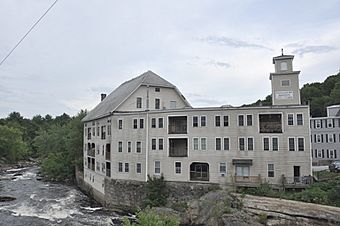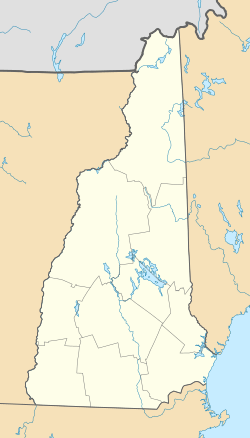Contoocook Mills Industrial District facts for kids
|
Contoocook Mills Industrial District
|
|
 |
|
| Location | Between Mill St. and Contoocook River, Hillsborough, New Hampshire |
|---|---|
| Area | 3 acres (1.2 ha) |
| Built | 1738 |
| NRHP reference No. | 75000124 (original) 85003530 (increase) |
Quick facts for kids Significant dates |
|
| Added to NRHP | June 10, 1975 |
| Boundary increase | December 12, 1985 |
The Contoocook Mills Industrial District is a group of old factory buildings in Hillsborough, New Hampshire. These buildings were once part of the Contoocook Mills, a very important business in the town for over 100 years, from the 1800s to the mid-1900s.
Factories and businesses started along the Contoocook River in Hillsborough a long time ago, around 1763. Back then, there was a sawmill (for cutting wood) and a gristmill (for grinding grain). More modern factory work began in 1828 when Josiah Marcy built a cotton mill. This building was three stories tall and made of wood. It stood on the south side of Mill Street. Water from a special channel, called a raceway, flowed through its stone foundation to power the mill. Josiah Marcy built more mills, like another gristmill and a sawmill, before he passed away in 1848. The brick gristmill building on the north side of Mill Street was used for grinding grain until 1884. After that, it became part of the main mill complex.
The Main Mill Complex
The most important part of the factory area is called the "main mill." It sits right next to the river's waterfalls. This main mill is actually two buildings that are connected. The part closer to Bridge Street was built in 1865. It was made of wood and built by John Butler Smith. He bought the mills from Josiah Marcy's family. John Butler Smith also built other brick buildings, like the dye house (where fabrics were colored) and an office, located near the main mill.
What the Mills Made
John Butler Smith's business eventually became known as the Contoocook Mills Company. For many years, these mills were the biggest employer in the community. They mainly produced woolen underwear. Imagine how many people worked there to make all that!
Saving the Mills
The mills stopped operating in the early 1960s. Luckily, people in the local community worked hard to save them from being torn down. Today, some of the old mill buildings have been turned into homes. Others are still used for light industrial work, meaning smaller businesses.
A Historic Place
Because of their importance, some of the Contoocook Mills buildings were added to the National Register of Historic Places in 1975. This is a special list of places in the United States that are important to history. In 1985, more buildings from the mill complex were added to this list, making sure even more of this historic area is protected.



